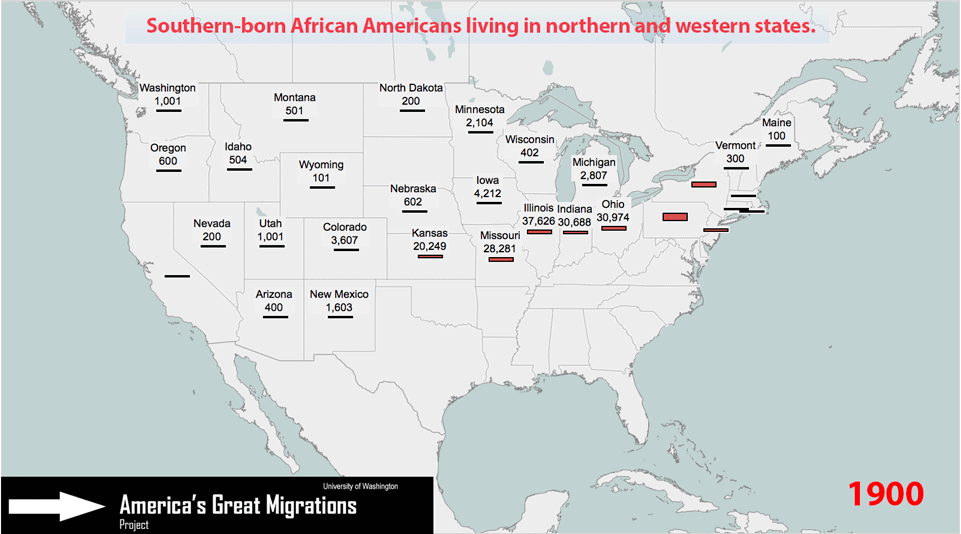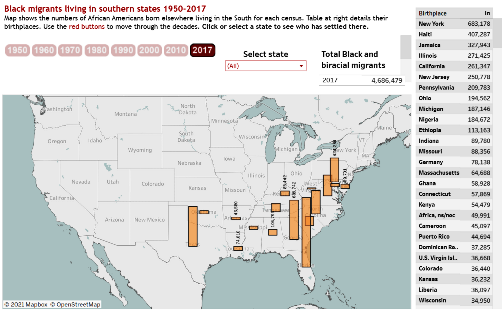 Southern family arriving in Chicago during World War I
Southern family arriving in Chicago during World War I
by James Gregory
Over the course of the 20th century, more than seven million African Americans left homes in the South to resettle in northern and western states. Historians have long described this exodus as the Great Migration, great not just because of the numbers of people who moved but also because of the social and political consequences. Once a people of the South, Black Americans became increasingly part of the big cities of all regions and in those urban settings steadily gained political and cultural influence. The Great Migration was thus key to the struggles and accomplishments of the long civil rights movement.
This page introduces resources for exploring the Great Migration, including several sets of interactive maps and tables showing where people settled and where they came from decade by decade.
How Many?
Migration out of the South was not new to the 20th Century, but volumes escalated through the first three decades of the new century, reaching a peak during World War I and the 1920s. Jobs in the North were part of the lure, especially as labor shortages encouraged companies to relax customary whites-only hiring restrictions. But other factors were also involved, notably the chance to exchange Jim Crow subordination for the greater freedom of cities outside the South.

Migration slowed dramatically in the 1930s, then soared during World War II and the two decades following, a period sometimes called the Second Great Migration. After the 1960s, rates of migration began to decline noticeably and by the 1980s former southerners were among those looking for opportunities in the new economy of the South, now renamed the Sunbelt.
The chart at right shows estimates of the volume of migration out of the South during each decade. It is based on calculations using the census survival method reported in James Gregory, The Southern Diaspora: How the Great Migrations of Black and White Southerners Transformed America. Since the publication of that book, Leah Platt Bouston (Competition in the Promised Land: Black Migrants in Northern Cities and Labor Markets) refined the method and clarified data problems that complicate estimates for the 1960s and 1970s. Accordingly, the chart reports only loose estimates for those decades.
 alt="mapping Great Migrations" border="1"
alt="mapping Great Migrations" border="1"
The image above is one of the maps and charts that we have developed to demonstrate the numbers of African American migrants leaving the South, the states and cities where they settled, and their states of origin for each decade 1900 to 2000. Follow the link to learn more. One map reveals decade-by-decade the number of southerners living in northern and western states. Select a state of origin and see where people went. Another map shows similar data for each metropolitan area where Black southerners settled. A third allows us to highlight a northern or western state and see which southern states contributed the most migrants. Or start with a southern state and see where its people went. Finally an interactive table provides the data behind these visualizations. Explore
 Migration out of the South slowed in the 1970s. Since then, Black Americans have been moving to the South in large numbers, in some sense reversing the Great Migration. But the story is more complicated than the slogan. The great exodus was largely from the rural South while the new migration has little to do with rural areas, or with states like Alabama, Mississippi, Arkansas, and Louisiana which saw so many leave during the exodus. The big cities of Georgia, Florida, Virginia, Texas, and North Carolina have attracted most of those participating in the Move South and typically this has not been a return migration. Some elders have returned home, but a strong majority are newcomers to the South, including many children or grandchildren of the exodus generation. Others are immigrants from the Caribbean and Africa. And the migration is transforming the South. Many of the migrants have come with advanced skills and education: some with resources to start new enterprises, others with the capacity to affect the culture and politics of southern places. Explore the interactive graphics and maps that track the reverse migration.
Migration out of the South slowed in the 1970s. Since then, Black Americans have been moving to the South in large numbers, in some sense reversing the Great Migration. But the story is more complicated than the slogan. The great exodus was largely from the rural South while the new migration has little to do with rural areas, or with states like Alabama, Mississippi, Arkansas, and Louisiana which saw so many leave during the exodus. The big cities of Georgia, Florida, Virginia, Texas, and North Carolina have attracted most of those participating in the Move South and typically this has not been a return migration. Some elders have returned home, but a strong majority are newcomers to the South, including many children or grandchildren of the exodus generation. Others are immigrants from the Caribbean and Africa. And the migration is transforming the South. Many of the migrants have come with advanced skills and education: some with resources to start new enterprises, others with the capacity to affect the culture and politics of southern places. Explore the interactive graphics and maps that track the reverse migration.
 Historians refer to one sequence as the Great Migration, referring to the exodus of more than seven million people from the South to states in the North and West in the decades between 1910 and 1970. But Black mobility began in the 19th century and continues into the 21st. Here are interactive graphics and maps that allow us to track the changing population of each state decade-by-decade since 1850. Select a state and see where Black residents were born, both other countries and other states. Explore
Historians refer to one sequence as the Great Migration, referring to the exodus of more than seven million people from the South to states in the North and West in the decades between 1910 and 1970. But Black mobility began in the 19th century and continues into the 21st. Here are interactive graphics and maps that allow us to track the changing population of each state decade-by-decade since 1850. Select a state and see where Black residents were born, both other countries and other states. Explore
Essays

 Southern family arriving in Chicago during World War I
Southern family arriving in Chicago during World War I
 alt="mapping Great Migrations" border="1"
alt="mapping Great Migrations" border="1" 
